Engaging with the Humanities
Professor Emma Smith reveals how sequels, celebrities and other showbusiness trends were born in the sixteenth century.
Before William Shakespeare became a legend, he was just part of the extraordinary explosion of creativity and entrepreneurial activity that over a period of around 30 years transformed the idea of theatre in England.
In this Engaging with the Humanities event, Professor Emma Smith draws on recent research and evidence from the archaeological investigations of the Rose Theatre on London’s Bankside. She explores the artistic and commercial innovations that first established theatres as permanent buildings in insalubrious parts of London and culminated in the publication of the iconic First Folio of Shakespeare’s plays in 1623.
Emma explains how the development of the theatre led to new jobs (playwright is one example), new problems (policing large crowds and parking carriages) and new opportunities (publishing). She also shows how the economics of the sector in this period led to ideas and activities that in some ways mirror today’s media and entertainment industries.
Sequels
It was only with the publication of the First Folio that Shakespeare’s Henry IV appears as a single play in two parts. Earlier play texts make it clear that the second part started life as Henry IV 2, featuring the return of popular characters from the first play – headlined by Sir John Falstaff.
Celebrities
Star players such as Richard Burbage and the comic actor Will Kemp developed fan followings – their name at the top of the bill would attract audiences in the way that a playwright would not. There is evidence emerging, too, that rich people would pay these star actors to attend events and ‘do a turn’ – rather as rich people now will book rock stars to play at their parties.
Market segmentation
Ordinary tickets for the big open-air theatres such as the Rose Theatre and the Globe were cheap: at one penny, they were roughly the price of two pints of beer. As the sector expanded, impresarios began to realise, not only that some theatre-goers would be prepared to pay more for seats further away from the stage, but that they would pay a lot more for a ‘boutique’ experience in a much smaller, more intimate surroundings. Theatre was starting its journey upmarket.
Watch Emma discussing four parallels with Elizabethan theatre and showbusiness today below, or watch the full event.

